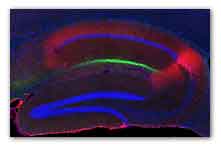News and Insights for
your best life. Online since 1998
- Home Health
- Breaking news
- In caso di...
- Per saperne di
più... - Medicina occidentale
- Medicine complementari
- Medicina cinese
e agopuntura - Omeopatia
- Fitoterapia

Memory formation requires the brain to create links between events at different points in time. These kinds of associations can be made by networks of neurons in the brain, but little is known about the networks involved. Susumu Tonegawa, Takashi Kitamura, Michele Pignatelli and colleagues from the RIKEN–MIT Center for Neural Circuit Genetics have now gained insight into how one such network is regulated.

Fluorescent staining shows that island cells (green) project into the CA1 region of the hippocampus.
Reproduced from Island cells control temporal association memory
Science 343, 896–901 (2014) © T. Kitamura et al.
Events separated in time become linked in the brain by connections between a region called the medial entorhinal cortex layer III (MECIII) and another called CA1 in the hippocampus, the brain’s memory center. Tonegawa’s team found that these connections are part of a neural network that is regulated by cells in the nearby entorhinal cortex layer II (ECII).
Most cells in the ECII make connections with an area of the hippocampus called the dentate gyrus. Using fluorescent staining, the researchers discovered a subset of ECII cells, called ‘island cells’, that make connections with CA1, the same area that connects to MECIII cells.
To investigate the function of island cells, the researchers used a technique called optogenetics. This involved artificially expressing light-responsive proteins in the island cells that can activate or deactivate the cells. This allowed the team to control island cell activity using an external light source.
Tonegawa’s team performed a series of experiments using mice. “We used a form of Pavlovian conditioning characterized by two steps,” explains Pignatelli. “The first was a training phase in which the mouse was exposed to a tone, followed after 20 seconds by a mild electric shock. The day after, the mouse was exposed to the same tone and we measure its freezing response.”
The freezing response is a sign of fear and indicates how strongly the mice associate the tone with the electric shock. Using optogenetics, the team found that they could reduce the fear response by activating island cells, or increase it by deactivating them. The effect was opposite in MECIII cells, leading the researchers to conclude that whereas MECIII cells create the association of the tone with the electric shock, ECII cells disrupt this process.
Pignatelli says that this regulatory mechanism ensures that only useful associations are made in the brain: “In nature, you need to associate certain events with each other, but you also need to avoid the association of other sets of events. Our findings reveal for the first time the neural circuits responsible for the temporal association and dissociation of events.”
See also
Neuroscientists Find Brain Activity May Mark the Beginning of Memories (2014-04-22)
For more information
Kitamura, T., Pignatelli, M., Suh, J., Kohara, K., Yoshiki, A., Abe, K. & Tonegawa, S.
Island cells control temporal association memory
Science 343, 896–901 (2014)
doi: 10.1126/science.1244634
MDN
del Dott. Turetta
Quali sono i problemi o le disfunzioni che possono giovarsi di un intervento omeopatico d'urgenza e, di conseguenza, come dovrebbe essere un ideale armadietto medicinale omeopatico casalingo.- Home -
- Health -
- Depressione -
- Sexuality
- Environment -
- Food -
- Musica -
- Capirsi -
- Grafologia -
- Ridere
Copyright © 1998/2018 www.mybestlife.com tutti i diritti sono riservati eccetto quelli già di altri proprietari.
.In caso di
Pubblicità
Per saperne di più su
Pubblicità
Pubblicità
Pubblicità
Pubblicità


